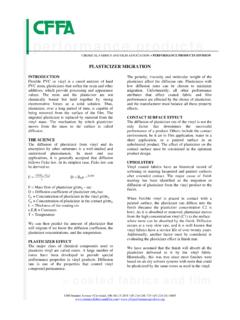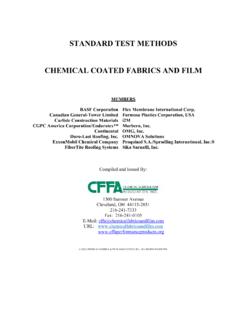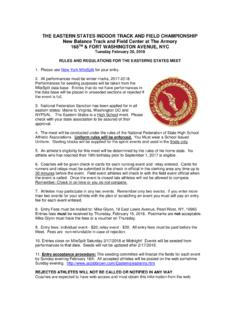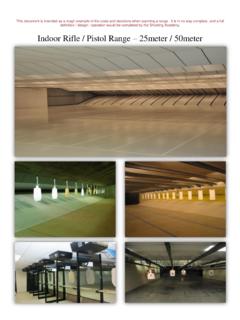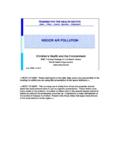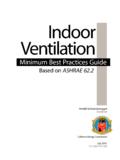Transcription of Minimum Performance Standards for VINYL …
1 CFFA U 201F August 2017 Recommended Minimum Performance Standards for VINYL coated AND other chemical coated upholstery FABRICS INDOOR 1. Scope This document sets forth recommended Performance Standards for VINYL and other chemical coated upholstery fabrics produced with woven, on woven, or knit substrates which are used as nupholstery materials for indoor furniture. This specification is not applicable to VINYL r chemical coated fabrics used in outdoor oapplications. This standard covers but is not limited to ther chemical coatings widely used for upholstery uch as urethane and acrylic. os 2. Applicable Documents* For applicable documents used in this specification, efer to CFFA Standard Test Methods Pamphlet, ost recent Edition.
2 Rm 3. Definitions Abrasion Measurement of the ability of the hemical coating to resist surface wear when crubbed against another (abradent) surface. Accelerated Light Aging A determination of the esistance of chemical coated fabrics to exposure to rlaboratory simulated sunlight. dhesionA A measure of the force required to e. separate a chemical coating from the base substrat locking B A determination of the development of surface tack at elevated temperatures. Cold Crack A measure of the ability of a chemical oated fabric to withstand cracking when folded at clow temperature. Crocking A measure of resistance to transfer of olor from a chemical coating to another surface usually a fabric ) by rubbing action.
3 C( Flex A determination of the change in surface appearance of a chemical coated fabric when subjected to multiple flex cycles. eam StrengthS Simulates the resistance of seam tearing. Tear Strength A measurement of the force equired to continue or propagate a tear in a coated rfabric. Tensile Strength A measurement of the force required to break a coated fabric . Volatility A measurement of weight loss of a chemical coated fabric when subjected to an elevated temperature. TABLE 1 PROPERTY TEST METHOD IKN TS NON WOVENS WOVENS Abrasion: Contract/ High Traffic Contract/ ommercial C General Use CFFA 1a #10 Duck 50,000 cycles 30,000 cycles 15,000 cycles 50,000 cycles 30,000 cycles 15,000 cycles 50,000 cycles 30,000 cycles 15,000 cycles Accelerated g Light AginCFFA 21 4 4 4 Adhesion CFFA 3 lbs.)
4 Lbs. 3 .0 CFFA 4 No Blocking Slight Adhesion N o BlockingSlight Adhesion N o BlockingSlight Adhesion Cold Crack C FFA 6a2No Cracking No Cracking No Cracking Crock Dry &ing: Wet CFFA 7 4 4 4 Flex CFFA 10 25,000 Cycles No Appreciable Crazing 25,000 Cycles No Appreciable Crazing 25,000 Cycles No Appreciable Crazing Seam Strength CFF 14 A30 x 25 lbs. 35 x 35 lbs. 25 x 25 lbs. Tear: Tongue Trap CFFA 16bCFFA 16c 4 x 4 lbs. NA NA 15 x 15 lbs. 4 x 4 lbs. NA Tensile CFFA 17 50 X 50 lbs. 50 X 50 lbs. 40 x 40 lbs. Volatility CFFA 183 8% 8% 8% 1200 hours using a Weatherometeor deometer, r yUsing a 5 lb. roller, 20 F ( C). Fa or 150 hours using a QUV dry c cle 2 3 Activated carbon technique, but at 220 F (104 C).
5 2014 chemical FABRICS & FILM ASSOCIATION, INC. ALL RIGHTS RESERVED 4. Performance equirements VINYL and other chemical coated upholstery fabrics are manufactured from natural and/or synthetic fibers chemically coated on one side to provide a durable, protective surface. Depending upon application, the coated fabrics will be colored, decorated and/or textured to provide an aesthetically pleasing appearance and feel. R2 Three coated fabric categories are vincluded: knits, wovens and non wo ens. See Table 1 for Minimum test values. Properties described in TABLE 1 for coated fabrics collectively make up the Minimum Performance Standards .
6 Depending upon specific tailoring and Performance requirements, these properties should be used to select the construction of coated fabric most suited for each end use. Properties are measured using CFFA Standard Test Methods. All test methods are outlined in the CFFA Standard Test Methods pamphlet which describes ir purtthe pose and relates the properties tesed to various aspects of Performance . The test results for coated fabrics, when tested in accordance with the CFFA Standard Test Methods, must attain the Minimum values of all properties listed in TABLE 1 for a given construction in order to conform to this standard. 5. Test Procedures Abrasion See CFFA Standard Test Method 1a. Wyzenbeek Methodusing #10 Duck as abradent.
7 Accelerated Light Aging See CFFA Standard Test Method 2. 200 hours using a Carbon Arc or Xenon Arc Weatherometer or Fadeometer, or hou150 rs using a QUV, dry cycle. See CFFA Standard Test Method 2. Adhesion of Coating to fabric See CFFA dard Stan Test Method 3. Use a Scott or Instron type Universal Tester. Blocking See CFFA Standard Test Method Samp4. les heated face to face under a standard weight. Cold Crack Resistance See CFFA Standard Test Method 6a. Use a 5 lb. Roller. Crocking Resistance Dry & Wet. See A StanCFF dard Test Method 7. Use CFFA evaluation scale. Flex T See CFFA Standard Test Method 10, Use a Flexometer (Newark Flex) Test Unit. Seam Strength See CFFA Standard Test Method 14.
8 Use a Scott or Instron type Universal Tester. Tearing Strength See CFFA Standard Test od 1 Meth 6b and 16c. Use a Scott or Instron type Universal Tester. Tensile Strength See CFFA Standard Test od 1 Meth 7. Use a Scott or Instron type Universal Tester. Volatility based on Activated Carbon except at 220 F. (104 C.). See CFFA Method 18. Technique, Standard Test 6. Notes Flammability If there is a flammability requirement, such requirement shall be as agreed upon by user and supplier. Multiple and relevant test methods appropriate for specific flammability ormaperf nce are too numerous to be included in this standard. Stretch and Set Stretch and set properties are often required by the user.
9 However, this standard covers such a wide range of products that vary in these properties that it is not feasible to provide meaningful values. Stretch and set pertiea anpro s should be as greed upon by user d supplier. See CFFA Standard Test Method 15. Mildew and/or Bacterial Resistance In some upholstery applications (hospital, healthcare, etc.), biological resistance requirements may be incorporated into the specifications to meet the needs of the final customer. CFFA Standard Test Method 120 Mildew Resistance and CFFA Standard Test Method 300 Bacterial Resistance can be ns to added to the specific product specificatiofacilitate the customer s needs. Accelerated Exposure to Disinfectants In some upholstery applications (hospital, healthcare, etc.)
10 Disinfectants are applied on a regular basis and may harm the surface by color or gloss change, cracking, peeling, or hardening. CFFA Standard Test Method 100 Accelerated Exposure to Disinfectants can be added to the specific product specifications to determine resistance. However, it should be noted that failing to rinse properly or use disinfectants at proper dilution ratios can shorten the useful life of the product, and is the most common basis of complaints. *Test Methods may be accessed on line at: MEMBERS BASF Corporation ExxonMobil chemical Company BYK USA, Inc. Formosa Plastics Corporation, USA CGPC America Corporation/Enduratex Morbern, Inc.
